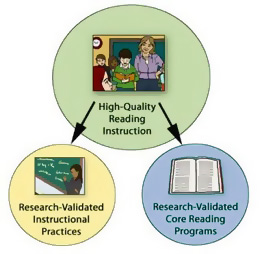RTI (Part 3): Reading Instruction
Wrap Up
RTI promotes:
 High-quality instruction for all students
High-quality instruction for all students- Early intervention for struggling readers
- Early identification of students with learning disabilities
These benefits result from teachers using high-quality instruction and frequent progress monitoring. High-quality instruction consists of research-validated classroom instructional practices and a comprehensive core reading program, which must address these five components:
- Phonemic awareness
- Phonics and word study
- Fluency
- Vocabulary
- Reading comprehension
Finally, the RTI approach encourages school personnel to collaborate in their efforts to meet students’ instructional needs and to accommodate students’ cultural or linguistic differences as they work through the various tiers and types of interventions.
Below is a table that summarizes instruction for Tiers 1, 2, and 3.
| Tier 1 | Tier 2 | Tier 3 | |
| Who receives instruction | All students | Students who are not making adequate progress with Tier 1 instruction alone | Students who are not making adequate progress with Tier 2 instruction |
| Amount of daily instruction | Instruction should occur for at least 90 minutes |
Instruction may vary, depending on the age of the student, from 30–45 minutes per day (+ Tier 1):
|
Instruction may vary, depending on the age of the student, from 40-60 min. per day (+ Tier 1) |
| When instruction is provided | During core reading time |
Scheduling options for Tier 2 could include:
If a large percentage of students require Tier 2 intervention, the teacher may need to schedule more than one Tier 2 intervention period per day. |
Scheduling options for Tier 3 could include:
|
| Duration of instruction | Entire school year |
10 weeks–20 weeks:
|
Varies by individual—may be several semesters or even years |
| How instruction is implemented |
Flexible grouping, which includes:
|
Instruction should be implemented with teacher/ student ratios of 1:3–1:5. | Instruction should be implemented with teacher/ student ratios of no more than 1:3. |
| Frequency of progress monitoring | At least one time every 1–2 weeks | At least one time every 1–2 weeks | At least one time every 1–2 weeks |
| Who provides instruction |
|
|
|
| Where students are served | General education classroom | Within or outside the general education classroom | Generally, outside of the general education classroom. This can but does not always include special education. |
Revisiting Initial Thoughts
Think back to your initial responses to the following questions. After working through the resources in this module, do you agree with your Initial Thoughts? If not, what aspects of your answers would you change?
What is RTI?
How can teachers increase student reading success in early grades?
What components comprise high-quality reading instruction?
How is high-quality instruction integrated into the RTI approach?
When you are ready, proceed to the Assessment section.